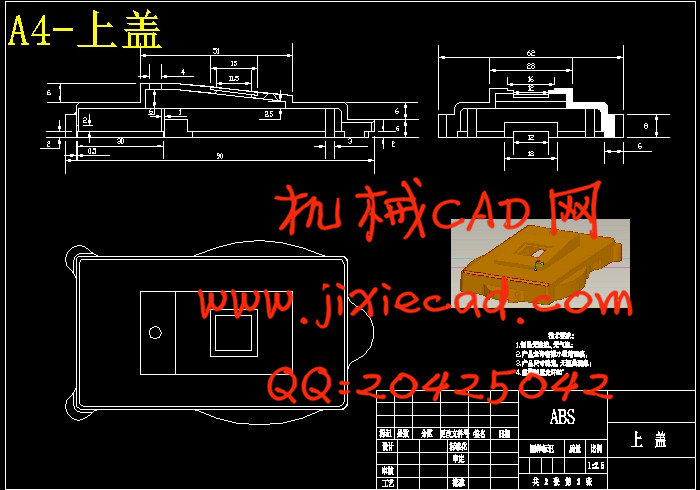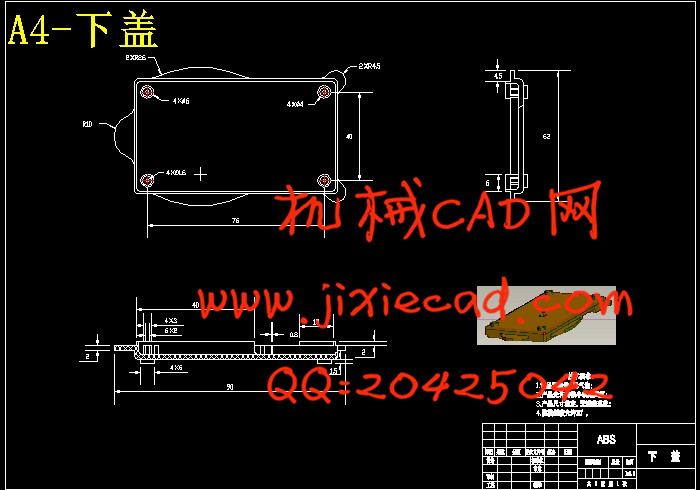设计简介
摘 要
对可移动野外防盗系统外壳进行结构和模具进行设计是本次论文的任务。主要内容是对野外防盗系统外壳上、下盖进行结构设计,在野火版PRO/ENGINEER Wildfire环境下绘制上、下盖的三维视图并对其进行装配;设计时要求结构简单、实用、外形美观并且方便制造。对上、下盖的模具设计,采用一模两腔的注射模结构,有利于节约成本,缩短生产周期和提高生产效率。本次可移动野外防盗系统的模具设计充分考虑了材料和人员的因素. 在注射模的设计过程中,对注射模浇注系统、冷却系统和成型零部件的各项参数进行了详细的计算,并对模具的主要零件的制造工艺进行了分析,最后对设计做了总结和分析。
关键词:野外防盗系统,结构设计,模具设计,制造工艺,AUTO CAD2004,Pro/E
ABSTRACT
The design of the Transportable open country security system including the structure and mould design is mainly about were in the article. It in request made a design of the cover of the Parking distance control(PDC) mainframe which included drawing its 3D view and assembling them in the environment of PRO/ENGINEER Wildfire; It is very important to make the structure simple ,practical, easy to manufacture and also have a good shape. In the progress of the mould design of the shell, a one mould-two cavity structure of injection mould was adopted, so that it can save money, shorten the period and improve the productivity. The mould guarding against theft systematically designs the Bencike displacement open country having considered material and personnel's factor sufficiently. The parameters of feed system ,cooling system, moulding parts was calculated detailedly, also the manufactural technics of main accessory of the mould was analysed. Have been used for a summary and have analysed finally to design.
Keywords: Transportable open country security system,Structure design ,Mold design,manufactural technics,AUTO
目 录
中文摘要 …………………………………………………………………………Ⅰ ABSTRACT …………………………………………………………………………Ⅱ
第1章 绪论 ………………………………………………………………………1
1.1野外可移动报警装置简介 …………………………………………………1
1.1.1 传感器的工作原理 …………………………………………………1
1.1.2 野外可移动报警装置的功用和组成结构 ……………………………2
1.2目前出现的一些防盗报警系统的功能和外形结构介绍 ………………3
1.3 本次的设计内容 …………………………………………………………5
第2章 野外可移动报警装置主机外壳的结构设计 …………………………7
2.1方案设计 ………………………………………………………………7
2.1.1 本次结构设计的目标…………………………………………………7
2.1.2 设计路线………………………………………………………………7
2.2 塑件材料的选择 ……………………………………………………………7
2.3 结构设计的工艺要求 ………………………………………………………9
2.3.1 塑件的尺寸和精度 …………………………………………………9
2.3.2 塑件的表面粗糙度 …………………………………………………9
2.3.3 塑件的结构形状 ……………………………………………………9
2.3.4 脱模斜度 ……………………………………………………………9
2.3.5 壁厚 …………………………………………………………………10
2.3.6 圆角 …………………………………………………………………10
2.3.7 孔 ……………………………………………………………………10
2.4零部件的设计 …………………………………………………………11
2.4.1 上盖 …………………………………………………………………11
2.4.2 下盖 …………………………………………………………………12
2.5 整体结构形式 ……………………………………………………………13
2.6 仪器的安装与固定 ………………………………………………………14
第3章 模具设计 ………………………………………………………………15
模具设计 ………………………………………………………………15
3.1 注射成型原理及其工艺过程 ……………………………………………15
3.1.1 塑料成型的基本原理 ………………………………………………15
3.1.2 工艺过程 ……………………………………………………………15
3.2 注射机的选择 ……………………………………………………………16
3.2.1 注射机类型的选择 …………………………………………………16
3.2.2 最大注射量的校核 …………………………………………………16
3.2.3 注射压力的校核 ……………………………………………………17
3.2.4 锁模力的校核 ………………………………………………………18
3.2.5 安装模具部分的尺寸的校核 ………………………………………18
3.2.6 开模行程的校核 ……………………………………………………19
3.2.7 顶出装置的校核 ……………………………………………………20
3.3 标准模架的选择 …………………………………………………………20
3.4 型腔的分布及分型面的确定 ……………………………………………20
3.5 成型零部件的设计 ………………………………………………………21
3.5.1 凹模和凸模的结构设计 ……………………………………………21
3.5.2 成型零部件工作尺寸计算 …………………………………………22
3.6 浇注系统的设计 …………………………………………………………26
3.6.1 主流道的设计 ………………………………………………………26
3.6.2 冷料穴设计 …………………………………………………………27
3.6.3 分流道设计 …………………………………………………………28
3.6.4 浇口的设计 …………………………………………………………29
3.7 排气系统的设计 …………………………………………………………30
3.8 冷却系统的设计 …………………………………………………………30
3.8.1 冷却系统的设计原则 ………………………………………………30
3.8.2 冷却管道数目的简易计算 …………………………………………30
3.9 脱模机构的设计 …………………………………………………………33
3.9.1 脱模机构的设计原则 ………………………………………………33
3.9.2 推出零件尺寸的确定 ………………………………………………33
3.10 导向机构的设计 …………………………………………………………34
3.11 模具整体结构的确定和标准件的选用 …………………………………34
第4章 模具制造工艺的分析 ……………………………………………………36
4.1加工工序的安排原则 ………………………………………………………36
4.2 模具中主要零件制造工艺的分析 ………………………………………37
结论 ………………………………………………………………………………39
致谢 ……………………………………………………………………………40
参考文献 …………………………………………………………………………41
对可移动野外防盗系统外壳进行结构和模具进行设计是本次论文的任务。主要内容是对野外防盗系统外壳上、下盖进行结构设计,在野火版PRO/ENGINEER Wildfire环境下绘制上、下盖的三维视图并对其进行装配;设计时要求结构简单、实用、外形美观并且方便制造。对上、下盖的模具设计,采用一模两腔的注射模结构,有利于节约成本,缩短生产周期和提高生产效率。本次可移动野外防盗系统的模具设计充分考虑了材料和人员的因素. 在注射模的设计过程中,对注射模浇注系统、冷却系统和成型零部件的各项参数进行了详细的计算,并对模具的主要零件的制造工艺进行了分析,最后对设计做了总结和分析。
关键词:野外防盗系统,结构设计,模具设计,制造工艺,AUTO CAD2004,Pro/E
ABSTRACT
The design of the Transportable open country security system including the structure and mould design is mainly about were in the article. It in request made a design of the cover of the Parking distance control(PDC) mainframe which included drawing its 3D view and assembling them in the environment of PRO/ENGINEER Wildfire; It is very important to make the structure simple ,practical, easy to manufacture and also have a good shape. In the progress of the mould design of the shell, a one mould-two cavity structure of injection mould was adopted, so that it can save money, shorten the period and improve the productivity. The mould guarding against theft systematically designs the Bencike displacement open country having considered material and personnel's factor sufficiently. The parameters of feed system ,cooling system, moulding parts was calculated detailedly, also the manufactural technics of main accessory of the mould was analysed. Have been used for a summary and have analysed finally to design.
Keywords: Transportable open country security system,Structure design ,Mold design,manufactural technics,AUTO
目 录
中文摘要 …………………………………………………………………………Ⅰ ABSTRACT …………………………………………………………………………Ⅱ
第1章 绪论 ………………………………………………………………………1
1.1野外可移动报警装置简介 …………………………………………………1
1.1.1 传感器的工作原理 …………………………………………………1
1.1.2 野外可移动报警装置的功用和组成结构 ……………………………2
1.2目前出现的一些防盗报警系统的功能和外形结构介绍 ………………3
1.3 本次的设计内容 …………………………………………………………5
第2章 野外可移动报警装置主机外壳的结构设计 …………………………7
2.1方案设计 ………………………………………………………………7
2.1.1 本次结构设计的目标…………………………………………………7
2.1.2 设计路线………………………………………………………………7
2.2 塑件材料的选择 ……………………………………………………………7
2.3 结构设计的工艺要求 ………………………………………………………9
2.3.1 塑件的尺寸和精度 …………………………………………………9
2.3.2 塑件的表面粗糙度 …………………………………………………9
2.3.3 塑件的结构形状 ……………………………………………………9
2.3.4 脱模斜度 ……………………………………………………………9
2.3.5 壁厚 …………………………………………………………………10
2.3.6 圆角 …………………………………………………………………10
2.3.7 孔 ……………………………………………………………………10
2.4零部件的设计 …………………………………………………………11
2.4.1 上盖 …………………………………………………………………11
2.4.2 下盖 …………………………………………………………………12
2.5 整体结构形式 ……………………………………………………………13
2.6 仪器的安装与固定 ………………………………………………………14
第3章
3.1 注射成型原理及其工艺过程 ……………………………………………15
3.1.1 塑料成型的基本原理 ………………………………………………15
3.1.2 工艺过程 ……………………………………………………………15
3.2 注射机的选择 ……………………………………………………………16
3.2.1 注射机类型的选择 …………………………………………………16
3.2.2 最大注射量的校核 …………………………………………………16
3.2.3 注射压力的校核 ……………………………………………………17
3.2.4 锁模力的校核 ………………………………………………………18
3.2.5 安装模具部分的尺寸的校核 ………………………………………18
3.2.6 开模行程的校核 ……………………………………………………19
3.2.7 顶出装置的校核 ……………………………………………………20
3.3 标准模架的选择 …………………………………………………………20
3.4 型腔的分布及分型面的确定 ……………………………………………20
3.5 成型零部件的设计 ………………………………………………………21
3.5.1 凹模和凸模的结构设计 ……………………………………………21
3.5.2 成型零部件工作尺寸计算 …………………………………………22
3.6 浇注系统的设计 …………………………………………………………26
3.6.1 主流道的设计 ………………………………………………………26
3.6.2 冷料穴设计 …………………………………………………………27
3.6.3 分流道设计 …………………………………………………………28
3.6.4 浇口的设计 …………………………………………………………29
3.7 排气系统的设计 …………………………………………………………30
3.8 冷却系统的设计 …………………………………………………………30
3.8.1 冷却系统的设计原则 ………………………………………………30
3.8.2 冷却管道数目的简易计算 …………………………………………30
3.9 脱模机构的设计 …………………………………………………………33
3.9.1 脱模机构的设计原则 ………………………………………………33
3.9.2 推出零件尺寸的确定 ………………………………………………33
3.10 导向机构的设计 …………………………………………………………34
3.11 模具整体结构的确定和标准件的选用 …………………………………34
第4章 模具制造工艺的分析 ……………………………………………………36
4.1加工工序的安排原则 ………………………………………………………36
4.2 模具中主要零件制造工艺的分析 ………………………………………37
结论 ………………………………………………………………………………39
致谢 ……………………………………………………………………………40
参考文献 …………………………………………………………………………41





